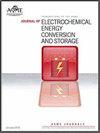棕榈植物废弃物中碳活化型硬币的自粘性能及用作高性能超级电容器电极的研究
IF 1.9
4区 工程技术
Q3 ELECTROCHEMISTRY
Journal of Electrochemical Energy Conversion and Storage
Pub Date : 2022-11-17
DOI:10.1115/1.4056268
引用次数: 3
摘要
利用棕榈植物废弃物合成具有自粘特性的生物质基碳质材料,转化成硬币状,作为超级电容器电极,具有高功率和能量密度、高比电容、优异的导电性、低成本、环保等特点。因此,本研究旨在探索一种简单而经济的方法,从棕榈植物废弃物生物质,即槟榔叶中脉(ALM)中产生多孔碳活化。通过预炭化、碱性化学活化、两步热解,即在600°C N2和700°C CO2气氛下炭化和物理活化,得到ALM衍生的活性炭(AC)材料。其物理性质表现为高度石墨化或非晶化的sp2结构,在hkl平面上有两个倾角为2θ,约为24°和44°的倾斜峰。在双电极系统中,当扫描速率为1 mv−1时,由ALM生物质制成的交流超级电容器的电化学性能最高,比电容值为216 Fg−1。此外,该电池的最大能量密度为11 Whkg−1,功率密度为196 W kg−1。因此,本研究推荐了一种创新且环保的方法,可以在不添加纳米材料和外部掺杂杂原子的情况下生产用于储能的高性能超级电容器电池电极。本文章由计算机程序翻译,如有差异,请以英文原文为准。
The Self Adhesive Properties of Carbon Activated-Like Shape Coin Derived from Palmae Plant Waste and used as High-Performance Supercapacitor Electrodes
Synthesized biomass-based carbonaceous materials from Palmae plant wastes with self-adhesive properties, converted into coin-like shapes, are used as supercapacitor electrodes with high power and energy density, high specific capacitance, excellent electrical conductivity, low cost, and environmentally friendly. Therefore, this study aims to investigate a simple and cost-effective method to generate porous carbon activation from Palmae plant waste biomass, namely areca leaf midrib (ALM). Activated carbon (AC) material derived from ALM was obtained through pre-carbonization, alkaline chemical activation, and two-step pyrolysis, namely carbonization and physical activation at 600°C and 700°C in the N2 as well as CO2 atmosphere, respectively. Its physical properties show an sp2 structure with high graphitization or amorphousness and two sloping peaks in the hkl plane at an angle of 2θ, approximately 24° and 44°. The electrochemical properties of AC supercapacitor cells derived from ALM biomass have the highest specific capacitance value of 216 Fg−1 at a scan rate of 1 mVs−1 in a two-electrode system. Furthermore, the cell obtained a maximum energy density of 11 Whkg−1 and a power density of 196 W kg−1, respectively. Therefore, this study recommends an innovative and environmentally safe approach for producing high-performance supercapacitor cell electrodes for energy storage without adding nanomaterials and externally doped heteroatoms.
求助全文
通过发布文献求助,成功后即可免费获取论文全文。
去求助
来源期刊

Journal of Electrochemical Energy Conversion and Storage
Engineering-Mechanics of Materials
CiteScore
4.90
自引率
4.00%
发文量
69
期刊介绍:
The Journal of Electrochemical Energy Conversion and Storage focuses on processes, components, devices and systems that store and convert electrical and chemical energy. This journal publishes peer-reviewed archival scholarly articles, research papers, technical briefs, review articles, perspective articles, and special volumes. Specific areas of interest include electrochemical engineering, electrocatalysis, novel materials, analysis and design of components, devices, and systems, balance of plant, novel numerical and analytical simulations, advanced materials characterization, innovative material synthesis and manufacturing methods, thermal management, reliability, durability, and damage tolerance.
 求助内容:
求助内容: 应助结果提醒方式:
应助结果提醒方式:


